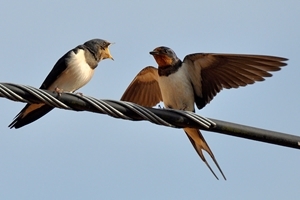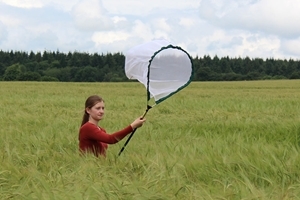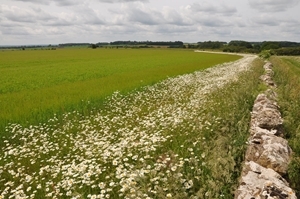Key points
- Financial support is available for farmers to leave margins around the edge of their fields to support wildlife, which are planted with a mixture of grasses, or grasses and flowers.
- It is not known whether these areas, which support more insects, spiders and other creatures at ground level, also benefit species that feed in the air.
- This study looked at feeding barn swallows and analysed whether they were more likely to be found near grassy margins or those enhanced with more flowers.
- Barn swallows were seen feeding over enhanced margins more often than over grassy margins.
- Enhanced margins are beneficial to a wide range of species, and this study is the first to show that they may be good for birds that feed in the air.
Background
 In the past century, farmland birds have declined in number across Europe, which is thought to be linked to modern farming methods. For some species this is at least partly because they eat insects, which are also declining, so their food resources are less plentiful. This is well known for ground-dwelling birds like the grey partridge, which are reliant on chick-food insects, as well as other species that gather food for their chicks on the ground such as yellowhammers and corn buntings. Agri-environment schemes aimed at helping these species are in place, and these work by providing areas that support more invertebrates, as well as extra nesting habitat.
In the past century, farmland birds have declined in number across Europe, which is thought to be linked to modern farming methods. For some species this is at least partly because they eat insects, which are also declining, so their food resources are less plentiful. This is well known for ground-dwelling birds like the grey partridge, which are reliant on chick-food insects, as well as other species that gather food for their chicks on the ground such as yellowhammers and corn buntings. Agri-environment schemes aimed at helping these species are in place, and these work by providing areas that support more invertebrates, as well as extra nesting habitat.
Within agri-environment schemes, farmers can apply for financial support to plant margins around the edge of their fields instead of growing crops right up to the edge. These can either be grass margins, which are usually sown with five grass species that form tussocks, or they can be enhanced with a mixture of up to 21 wildflower species. Both are good for wildlife, but the more complex structure and higher number of flower species in enhanced margins mean that more invertebrates, of a wider variety of species, are found there.
Little is known about whether these habitats, designed to provide more invertebrates on the ground, can also help those species that eat flying insects. Barn swallows feed on invertebrates in the air, mostly on large flies like house and stable flies. This work studied how feeding barn swallows use field margins that were planted with the support of agri-environment schemes.
What they did
 GWCT scientists carried out 112 surveys across five farms in Hampshire and Dorset. These farms included both grass margins and enhanced margins, and there were barn swallows nesting within 600m of the survey sites, in groups of between two and eight pairs.
GWCT scientists carried out 112 surveys across five farms in Hampshire and Dorset. These farms included both grass margins and enhanced margins, and there were barn swallows nesting within 600m of the survey sites, in groups of between two and eight pairs.
The scientists counted swallows from stationary points along fixed lines, or transects, that were 70m long. These included either a grass or floristically enhanced margin. These surveys were carried out in the mornings in June and July, recording where and when within that area barn swallows were seen feeding. They analysed:
- The likelihood of seeing swallows feeding over a margin.
- Where they were seen, the maximum number that were present.
They also took samples of invertebrates from the air by using a large, lightweight net, which was swept through the air 30 times at between 0.5 and 1.5m off the ground.
What they found
Barn swallows were recorded feeding on just over a third of the study transects. When they were present, between 1 and 34 were seen at any one time.
The likelihood of seeing barn swallows feeding was 13% higher if the site included an enhanced flower margin, compared to those that included grass margins. Swallows were less likely to be seen feeding if the sample area contained a treeline compared to if it didn’t.
However, if swallows were seen, there was no difference in the number seen or the length of time they spent feeding in that area.
What does this mean?
 Farmland that contains margins enhanced with wildflowers can support a higher number of several bird species, and this study found that barn swallows were more likely to feed over these margins compared to those sown with grass mixes. Enhanced margins can improve breeding success for some species of farmland bird, and because they provide a good source of insect food over a longer period than grassy habitats, this may also benefit barn swallows.
Farmland that contains margins enhanced with wildflowers can support a higher number of several bird species, and this study found that barn swallows were more likely to feed over these margins compared to those sown with grass mixes. Enhanced margins can improve breeding success for some species of farmland bird, and because they provide a good source of insect food over a longer period than grassy habitats, this may also benefit barn swallows.
No previous studies have looked at how bird species that feed in the air use agri-environment scheme habitats, and this paper using barn swallows as an example shows that agri-environment schemes that are already in place to improve biodiversity on the ground may also contribute to supporting species above.
Read the original abstract
McHugh, N.M., Bown, B.L., & Clark.J.E. (2018). Use of field margins managed under an agri-environment scheme by foraging Barn Swallows Hirundo rustica. Bird Study, 65: 329-337.